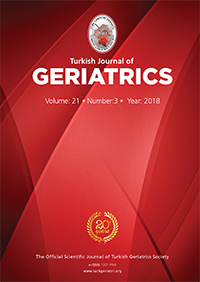2Yüzüncü Yıl University, Medical Faculty, Radiology, Van, Turkey DOI : 10.31086/tjgeri.2018344054 Introduction: This study aimed to evaluate the clinical and radiographic effectiveness of extracorporeal shock wave therapy to treat primary medial knee osteoarthritis with and without bone marrow edema in elderly patients.
Materials and Method: Elderly patients with right knee osteoarthritis and bone marrow edema confirmed by magnetic resonance imaging were allocated to the first group (n=40), whereas patients without bone marrow edema were randomly allocated to either the second (n=40) or third (n=40) groups. The patients were treated twice weekly with a total of 10 sessions of extracorporeal shock wave therapy (Groups 1 and 2) or were left untreated with sham extracorporeal shock wave (Group 3).
Results: The comparison of the patients" Visual Analogue Scale, Western Ontario and McMaster Universities Osteoarthritis Index and Lequesne scores before treatment and at 6 months and 1 year after treatment revealed significant score reductions in the first and second groups (p<0.05). One year after treatment, the medial joint space was preserved in Groups 1 and 2 (p<0.05), whereas the medial joint width protection was more prominent in Group 1 (p<0.05) than in Groups 2 and 3.
Conclusion: In elderly patients with knee osteoarthritis, extracorporeal shock wave therapy led to functional and radiologic improvements and pain relief without substantial complications. The improvement remained at the 1 year follow-up and was higher in patients with bone marrow edema. Further studies are required to investigate its potential as a diseasemodifying physical agent, particularly for treating elderly patients with knee osteoarthritis with bone marrow edema.
Keywords : Aged; Osteoarthritis, knee; Extracorporeal shock wave therapy
